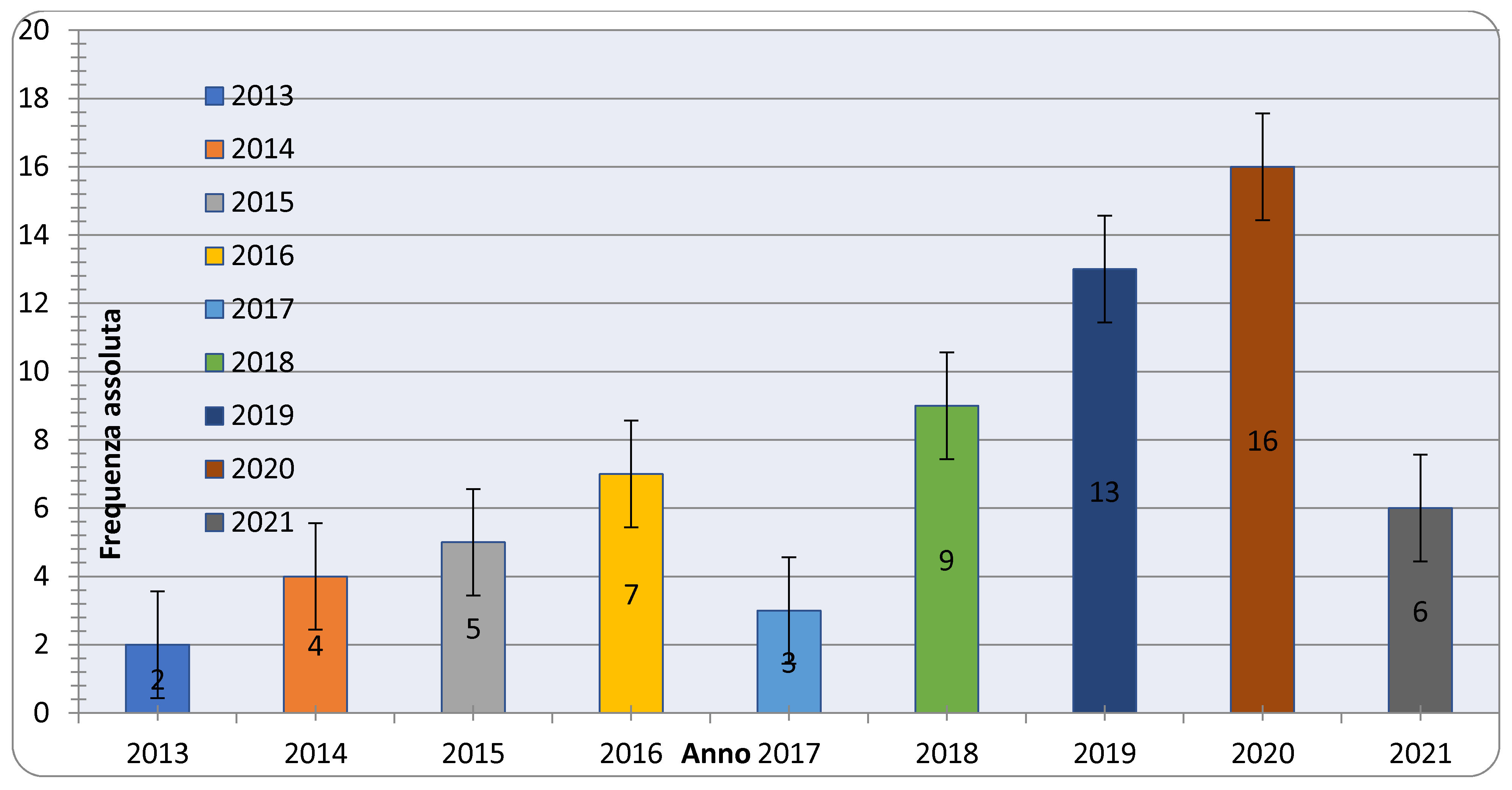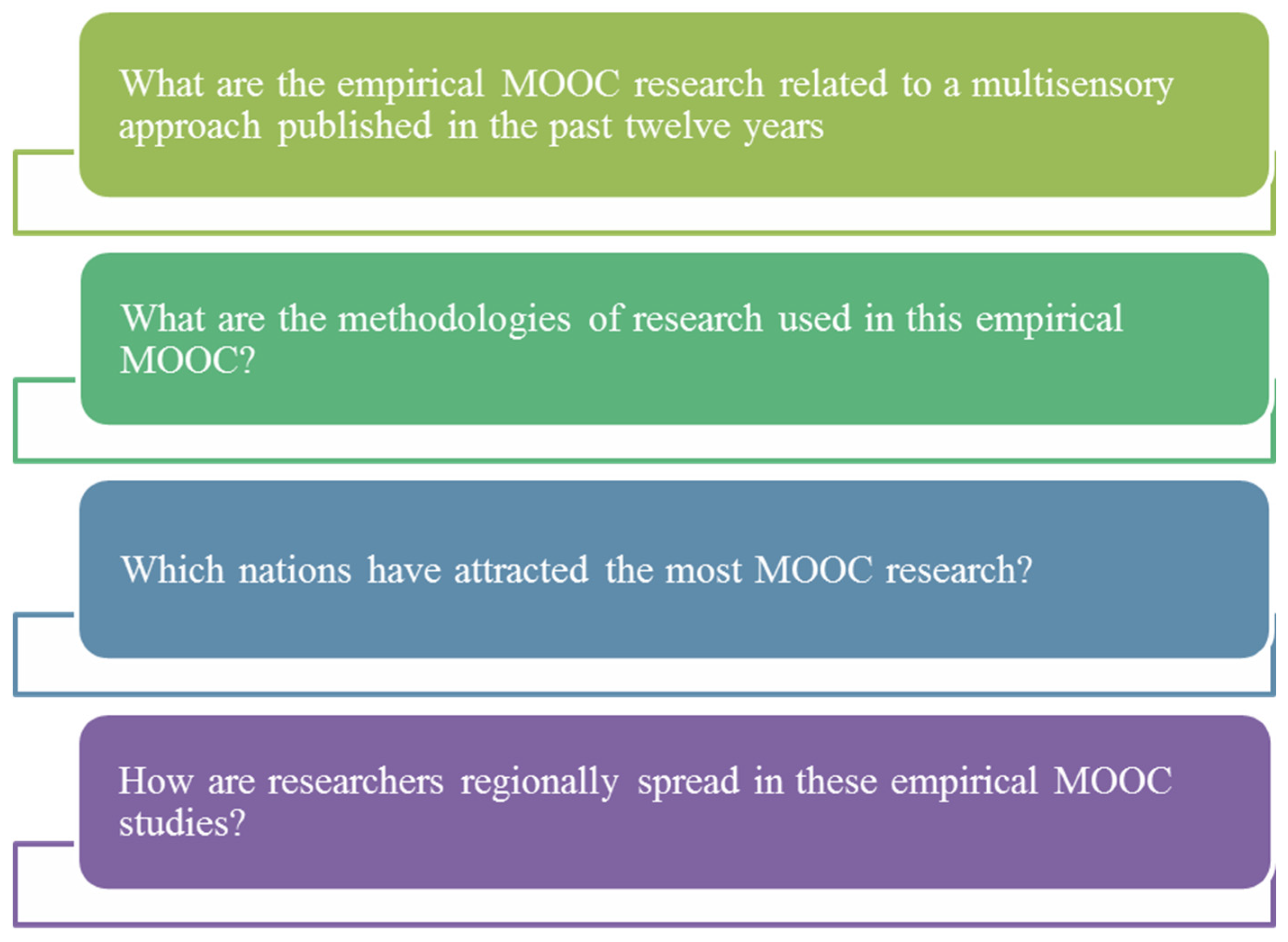Massive Open Online Courses (MOOCs) have been described as a “next development of networked learning”, and they have the potential to mediate sensory learning. Most sMOOC exploration, partudies were based on quantitative research methods followed by mixed research methods and the qualitativeicularly on sensory learning, to date has zeroed in on student issues, for example, the student experience, social learning, commitment, self-controlled learning, inspiration, execution, and MOOC finish. Instead, research approaches; most of the studies were surveys, followed by platform databases and interviews; almost half of the studies were conducted using at least two methods for data collection: survey and interviews; most were replicated. The most highlighted subjecton MOOC teachers has a minor impact. To address this hole, MOOC specialists later on might target educators or plan more extensive investigations of different MOOC partners such as students, teachers, educational originators, or program heads. More examinations of MOOC teachers’ plan cycle and discernments would enhance the comprehension of MOOC wonder. Such exploration could advance a more profound comprehension of the nature of MOOCs, social affectability in MOOCs, MOOC instructional methods included student retention, learning experience, social learning, and engagementing course intuitiveness and commitment, and evaluation rehearsals from MOOC educators’ points of view.
1. Introduction
Massive Open Online Courses (MOOCs) have been described as a “next development of networked learning” and as a platform for expanding accessibility to higher education and supporting new education methods. Coined in 2008
[1], MOOCs refer to online courses offered by colleges that draw thousands of participants, partially because they are “open”, generally referring to the fact that they do not offer credit and hence are free to someone with an internet connection. Massive Open Online Courses (MOOCs) are courses that extend the learning process to thousands of students. These courses respond to the challenges that educational and training institutions face in critical times such as these. MOOCs, in fact, represent quality training at a low cost
[2]. While there is limited official study into the nascent discipline, many fans of the format have enthusiastically embraced its implementation. The development and application of MOOCs in many fields of higher education and, more lately, health education and live science have increased dramatically
[1,3][1][3].
A long-studied strategy in the realm of training is to evaluate success and effectiveness and to advise on courses improvements. However, the distinctions between teaching in MOOCs and regular face-to-face classes mean that the same standard evaluation methodologies cannot be adapted. For instance, MOOCs often do not include entry, withdrawal, or submission of assignments or assessments restrictions
[4]. The approaches employed in web-based education and e-learning do not always apply to MOOCs because web-based or e-learning courses are sometimes delivered under curricula, which differ from MOOCs according to expectations of students. The low terminal completion rates of MOOCs indicate that there is a lack of self-regulation and self-motivation with respect to what is expected of students
[5].
It is not appropriate to compare MOOCs directly with higher education courses using typical assessment standards and criteria. OStur reviewdies focused on the queries highlighted in Figure 1, from which it can be seen that the research questions refer to empirical MOOCs, research referred to a multisensory approach (in the last twelve years), the research methodologies used in empirical MOOC, the analysis regarding the nations that have investigated MOOCs the most, and the diffusion of research, at a regional level, of empirical MOOCs referred to a multisensory approach.
Figure 1. Research questions.
Despite the limitations in MOOC evaluation methodologies, multiple reviews of MOOC-related research methods have been undertaken without focusing especially on MOOC evaluations
[6]. Two recent systemic reviews have been published summarizing methodologies and topics for MOOC research. Zhu et al.
[7,8][7][8] and Bozkurt et al. (2021)
[9,10][9][10] advocated additional research on MOOC evaluation methodological techniques.
This study focused little on the quality of the procedures and methodologies used. Furthermore, a considerable number of MOOC studies evaluate general pedagogic factors without assessing the course. While the broad review of MOOC education and pedagogy is valuable, it is also essential to evaluate courses
[7]. The assessment of the quality of learning through MOOCs has become an “educational” variant of the Big Data problem, as it is mediated by learning analytics
[11]. The application of learning analytics allows the identification of problems and potential. The dropout rate is an indicator not significantly associated with the effectiveness of MOOCs. Stracke
[12] underlined that some students consider their educational objectives to be achieved even by simply downloading the materials available to pursue self-regulated learning and using them outside the time provided by the MOOC. MOOCs allow a large number of users to be reached, guaranteeing easy and immediate access to knowledge and content and mediating online communication with the teacher or among peers
[12]. The online tutor is essential to favor monitoring processes in MOOCs with respect to both to the levels of completion of the course and to the management of information of a more qualitative nature, thus enhancing the relational dimension within the learning process
[13]. MOOCs allow the communication of automatic and personalized feedback by placing the individual in direct comparison with his or her colleagues. Students learn by comparing themselves with more or less experienced colleagues
[14]. MOOCs are offered in any different subject areas, such as STEM, art, medicine, and business, with differences in each subject area
[15,16][15][16]. Studies on learning, and in particular on perceptual learning, have focused on learning stimuli consisting of a single sensory modality. However,
ocur
rent experience in the world involves constant multisensory stimulation. For example, visual and auditory information is integrated into the performance of many tasks that involve locating and tracking moving objects. Therefore, the human brain is likely to have evolved to develop, learn, and operate optimally in multisensory environments. Multisensory learning is determined by a multisensory stimulation that induces a unified perception. Multisensory information has been shown to facilitate learning
[17].
2. Distribution Diaries for MOOC Research
The current examination investigated the distribution diaries for MOOC research just as exploration techniques directed, information assortment strategies, information examination techniques, research foci, creator’s geographic data, creators’ cooperation types, geographic data with respect to the conveyance of MOOCs, and the dispersion of the MOOC research by year of distribution
[35,40][18][19].
Figure 2 shows that the highest percentage of published articles refer to the year 2020, followed by 2019. Furthermore, most of the studies come from the United States, followed by the United Kingdom .

Figure 2. Distribution of MOOC publications.
3. Multimodality in the Classroom
The introduction of multimodality in the classroom requires an effort to accommodate teaching practice. Multimodal practice consists of the integration of specific modal resources: writing a recipe and then transforming it into a didactic discourse with the support of the Interactive Writing Boards (IWB); writing drafts and project texts starting from literary excerpts; debating in a reasoned way by developing a written text but then focusing on speech, its understanding, and critical analysis, as well as on the action; narrating starting from a video stimulus, transcribing spoken passages, and rewriting on the basis of a literary model
[41][20].
4. Area of Cognitive Styles
Multimodality is usually considered a perceptual multimodality; it leverages the idea that learners use different sensory modalities (visual, auditory, and body mobility). The discussed area of cognitive styles, understood as a multiplicity of approaches to learning contents, is added. In other words, beyond the perceptual level, information is organized and processed according to individual modalities that are affected by one’s personal history of learning
[42,43][21][22].
According to the current studies, in olfactory learning and not visual learning, transfer effects are detected, while task difficulties and learning rates were equivalent in both training tasks.
Based on our findings, we anticipate that olfactory system MOOCs learning could lead to more cross-sensory transmission than is the case of the visual system (which is the dominant model for cognitive interventions). Our results also underscore that the transfer of learning is often unrelated to the extent of the gains made in the MOOCs [37,44].
5. Future Perspectives
Further research is needed before the value of olfactory cognitive MOOCs learning can be determined. It is not obvious if the multimodal character of the learning tasks or the unknown variations in cognitive demands were the result of this shift, rather than the commitment of olfaction per se
[45,46][23][24]. This may lead to additional studies: each MOOCs learning exercise uses one type of sensory stimuli. Therefore,
we consider that the sensory complexity has a great value for a new generation of MOOCs. In th
ise direction, further stud
y is ies are needed where multimodal complexity of training tasks is changed
[47,48][25][26]. In conclusion, the comparison of the selected articles revealed the effectiveness of MOOCs in relation to the learning achieved by students and the increase of their motivation. Furthermore, these online courses facilitate the sharing and democratization of knowledge and the acquisition of practical skills in university and training environments. The new frontier is represented by the multisensory stimulation mediated by MOOCs to facilitate learning
.
We believe that the outcomes of our study will motivate more research on cognitive MOOCS learning based on odors [49]. Such operations could be advantageous for elderly people because olfactory deficits are the early indicators of cognitive impairment and dementia related to age [50,51,52].


